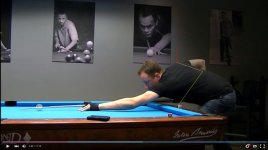bigskyblue...There are only two ways to deliver the cuestick...a piston stroke and a pendulum stroke. One involves elbow drop and one doesn't. Using a pendulum stroke allows the subconscious brain to "program" the biceps to deliver the cue along a natural range of motion, and almost any rate of acceleration, without "grabbing" tightly on the butt end of the cue. When the brain understands that the swing is a nonrandom linear range of motion, that is exceptionally repeatable and accurate, it can also train the hand not to grip the cue tightly...even when swinging quickly like on a break stroke. Excessive followthrough is unnecessary and more liable to produce inconsistent results. Letting the cue "do the work", instead of muscling the cue, creates what's called "kinetic energy" (think of a battering ram concept). The cue weighs 3x as much as the CB, therefore it can be swung naturally, operating only off of the elbow, with no drop, and generate huge amounts of energy without having to clamp down on the cuestick. Hope you understand what I'm talking about. :thumbup:
Scott Lee
http://poolknowledge.com


